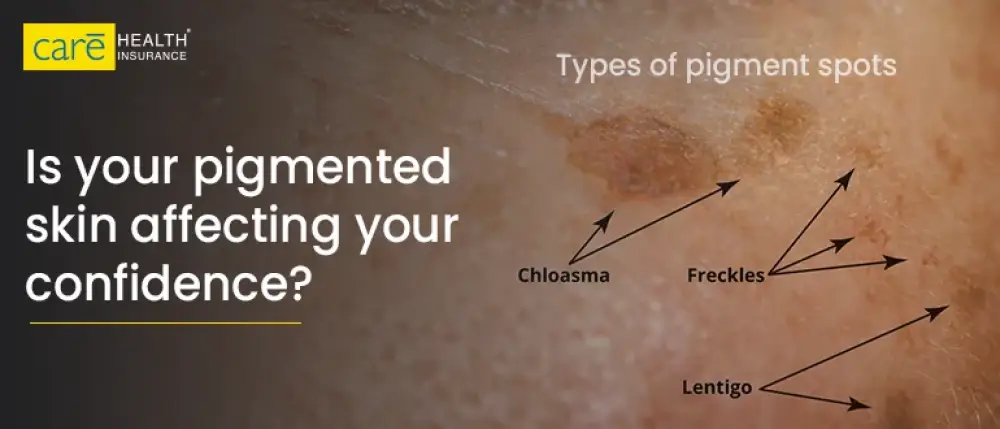Subscribe to get weekly insights
Always stay up to date with our newest articles sent direct to your inbox
Published on 8 Aug, 2025
Updated on 8 Aug, 2025
17 Views
4 min Read

Written by Nidhi Goyal
Reviewed by Akhil Pillai
favorite0Like
favoriteBe the First to Like
To cure skin pigmentation, you must understand its types and causes. While some pigmentation can be reversed completely, others may only be managed or reduced. The key is early detection and consistent treatment. Many pigmentation issues improve significantly with the right care. In this blog, you will gain a better understanding of what skin pigmentation is, its causes, treatments, and other related information.
Just a dose of motivation for those struggling with pigmented skin these days.
Every morning, the mirror tells Rita a different story.
She remembers the days her skin felt flawless and free.
Now, unfamiliar patches have taken over that confidence.
It’s not just about looks, it’s also about how she feels inside.
Self-confidence must never depend on one's looks. True self-confidence stems from self acceptance. Looks are fleeting; knowing your self-worth is crucial. Understanding skin pigmentation reasons can help you in prevention and treatment.
Skin pigmentation is caused by the following:
Skin pigmentation changes fall into two main categories: Hypopigmentation (lighter patches) and Hyperpigmentation (darker patches). Look at how your skin looks.
Occurs when melanin production decreases or stops. The common types of hypopigmentation include:
Caused by an overproduction of melanin. Key types of skin pigmentation are mentioned below:
Our skin’s colour is formed by a natural pigment called melanin, produced by specialised skin cells called melanocytes. Beyond defining your skin tone, melanin protects against sunburn, regulates body temperature, and even reduces the risk of skin cancer. Thus, the right composition of melanin is important for your overall well-being. Skin pigmentation is the dark spots or light patches appearing on the cheeks or forming around the arms.
Here are some effective ways to restore lost skin pigment:
Remember- Early skin care is smart care. So, choose a health insurance plan that covers consultations and dermatological support. Hyperpigmentation removal or skin pigmentation treatment costs Rs 5,000 to Rs 35,000. Secure your skin and finances too.
A few lifestyle changes and treatments may help.
Ever visited a dermatologist? Tell us how it helped. Your story could inspire someone!
A dermatologist can best describe how to treat skin pigmentation. Their expertise will help you treat your skin well, but what is the right time to make an appointment?
See a skin specialist if:
Taking care of your skin is part of caring for your health. Get covered for consultations, treatments, and more. Buy health insurance today and get coverage for unlimited e-consultations. Under the Care OPD plan of Care Health Insurance, you get covered for dermatology consultations. Also, with Instant Cover and PED Wait Period Modification, you can reduce the waiting time for your pre-existing condition and raise a claim just after the initial period of 30 days.
Your health insurance plan may also cover the cost of medicated creams or treatments. If your skin's dark/light patches result from post-surgical pigmentation, you might also get coverage. The treatment might also be covered if an underlying medical condition causes skin pigmentation.
Pigmentation is a common and treatable skin concern. Whether it’s caused by the sun, hormones, or inflammation, the key is early detection, the right skincare, and medical advice. With time and care, you can restore a more even, glowing complexion. The coverage of skin pigmentation depends on its cause, treatment, and policy coverage. Insurance may also cover the treatment cost of your surgery. Contact the best health insurance provider and build financial protection for yourself.
Disclaimer: The above information is for reference purposes only. Kindly consult your general physician for verified medical advice. Health insurance benefits are subject to policy terms and conditions. See policy documents for details.
favoriteBe the First to Like
शुगर कंट्रोल कैसे करे? जानें, डायबिटीज में क्या खाना चाहिए Vipul Tiwary in Health & Wellness
Thyroid : मामूली नहीं हैं महिलाओं में थायराइड होना, जानें इसके लक्षण और घरेलू उपचार Vipul Tiwary in Diseases
हाई ब्लड प्रेशर को तुरंत कंट्रोल कैसे करें? देखें इसके उपाय Vipul Tiwary in Diseases
प्लेटलेट्स की कमी के लक्षण, कारण और इलाज क्या है Vipul Tiwary in Diseases
What are Chilblains and How Can You Treat Them? Nidhi Goyal in Diseases
You Might Be Overlooking Spider Veins in These 5 Body Areas Nidhi Goyal in Diseases
Anaphylaxis: Causes, Symptoms & Emergency Steps Sejal Singhania in Diseases
How does Salpingitis Affect the Fallopian Tube Parts? Bhawika Khushlani in Diseases